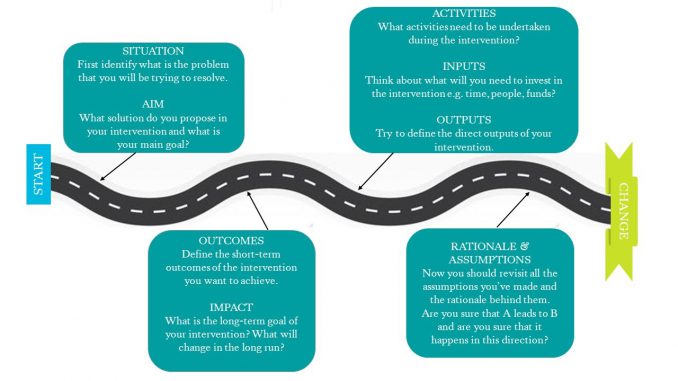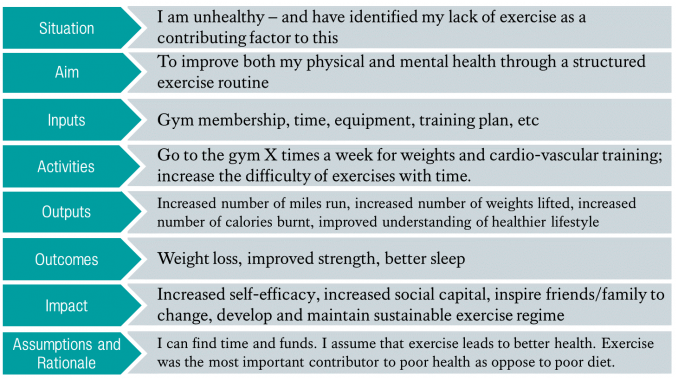
By Nadia Chechlińska, Research Associate|
Outreach staff are all working towards a common goal: equal opportunity of access to higher education. It’s an ambitious goal and it requires a lot of staff hours, planning, activities and funding. Here at King’s College London, we run a variety of projects to help students get into university and achieve their full potential once they are here. The task of pulling together such a large activity plan and demonstrating its impact is challenging, but important.
A key tool to help plan for an effective evaluation is your Theory of Change (also known as “ToC”). Theories of Change have been designed to help organisations who develop social change to create and articulate an effective plan of change. It helps them to identify in the planning stages the change you want to achieve and how you will measure that change.
Create your personalised theory of what will change
A Theory of Change is something that you develop either with your team or with stakeholders when working on an external project. This process enables all of you to build a shared understanding of the goals you want to achieve and how you plan to achieve them, which ensures positive team communication and protects you against mission creep.
A Theory of Change is not a specific theory of how to plan an intervention. It won’t tell you whether your ideas are good or bad or how to execute the particular change. It is a process of questioning your ideas and assumptions, and developing your own personalised theory of what will change when you put your ideas into practice. This tool enables you to plan your intervention step by step, helping you to identify possible pit falls early and be prepared for the complex process of achieving social change. Moreover, it’s a helpful road map of your project for new starters and key stakeholders and should be included in your Research Protocol (more information on those here).
Plan the steps of your change to ensure success
Designing your Theory of Change should be like a journey from long-term impacts to inputs, which follows a logical structure. You should design your Theory of Change with an impact-focussed approach; once you have established the change you wish to achieve – and crucially, how you plan to measure that – you can work backwards to plan appropriate activities, and articulate what resources are required for delivery.
There are key distinctions between our short-term outputs, medium-term outcomes, and long-term impacts. The outputs will happen as a direct result of your activity, your specified outcomes could happen, and your impact is what you hope to happen. Whilst you are in direct control of your outputs – providing your activities are delivered as planned – external factors can compromise your longer term outcomes and impacts. However, sometimes it can be difficult to envision how to achieve big-scale, long-term, ambitious change. A Theory of Change can help to break down this potentially overwhelming task into realistic, measurable and logical components. We’ve created the following example to help you visualize the process of designing a Theory of Change. Imagine yourself in a few weeks’ time – the Christmas season is over, the New Year is here and it is time for New Year’s resolutions. Perhaps you want to exercise more? We know that introducing a behaviour change isn’t easy – but a Theory of Change might help to make this move to a healthier lifestyle over the year a bit easier by breaking it down into more achievable tasks.
Making sure your intervention will lead to a change by focusing on the how
Exercising more is a simple example of a change that has a much bigger chance of being achieved if an appropriate Theory of Change is designed. For the complex interventions we design in widening participation, it’s even more useful for bringing all the threads together. Using a Theory of Change allows you to focus on how to achieve the change – it enables you to think about the potential causal relationship between your means and your goals and prompts you to ask yourself questions such as ‘is this doable?’ and ‘are my outputs testable?’. A Theory of Change should help you plan effectively, mitigate risks, uncover assumptions and spot possible issues in the early stage of project design. Most importantly, however, in the event of a negative or inconclusive result, a good Theory of Change provides you with the tools to distinguish why this was the case.
To learn more: if you are a member of King’s staff, contact us at whatworks@kcl.ac.uk or take a look at our Monitoring and Evaluation Framework in our intranet page. If you’re not at King’s, keep an eye on our Twitter (@KCLWhatWorks) for training opportunities!
______________________________________________________________________________________
Click here to join our mailing list.
Follow us on Twitter: @KCLWhatWorks



Leave a Reply